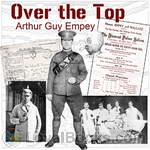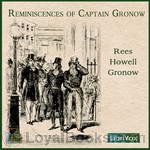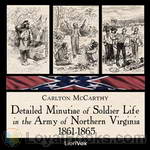|
Books Should Be Free Loyal Books Free Public Domain Audiobooks & eBook Downloads |
|
|
Books Should Be Free Loyal Books Free Public Domain Audiobooks & eBook Downloads |
|
War Stories |
|---|
|
Book type:
Sort by:
View by:
|
By: Anatole France (1844-1924) | |
|---|---|
 Gods are Athirst
Gods are Athirst
The Gods Are Athirst (French: Les dieux ont soif, also translated as The Gods Are Thirsty or The Gods Will Have Blood) is a 1912 novel by Anatole France. The story follows the young Parisian painter Évariste Gamelin, who rises speedily from his humble beginnings to a member of the Revolutionary Tribunal in the second and third year of the French Revolution. In brilliant prose, Anatole France describes how Évariste's idealism turns into fanaticism, and he allows more and more heads to roll and blood to flow, placing himself and those he loves into ever greater danger. | |
By: Andrew Lang (1844-1912) | |
|---|---|
 Story of Joan of Arc
Story of Joan of Arc
Joan of Arc is a folk heroine of France and a Roman Catholic saint. Claiming divine guidance, she led the French army to several important victories during the Hundred Years' War, which paved the way for the coronation of Charles VII of France. Captured by her enemies, she was sold to the English and put on trial for charges of "insubordination and heterodoxy". She was burned at the stake for heresy when she was 19 years old. Twenty-five years after her execution, an inquisitorial court examined the trial, pronounced her innocent, and declared her a martyr... | |
By: Ann Radcliffe (1764-1823) | |
|---|---|
 The Mysteries of Udolpho
The Mysteries of Udolpho
Considered a change agent in early Gothic romance; oft-referenced in later literary works or paid homage to by such authors as Jane Austen (influential novel ready by her heroine, Catherine Morland, in Northanger Abbey); Edgar Allen Poe (borrowed plot elements for the short story The Oval Portrait); and Sir Walter Scott. In The Mysteries of Udolpho, one of the most famous and popular gothic novels of the eighteenth century, Ann Radcliffe took a new tack from her predecessors and portrayed her heroine’s inner life, creating an atmosphere thick with fear, and providing a gripping plot that continues to thrill readers today... | |
By: Anonymous | |
|---|---|
 The Broken Vase and Other Stories
The Broken Vase and Other Stories
The Broken Vase and Other Stories;for Children and Youth,Compiled by a Teacher | |
 St. Clair's Defeat 1791
St. Clair's Defeat 1791
St. Clair's defeat was a battle fought between the United States and the Western Confederacy of Native Americans on November 4, 1791, during the Northwest Indian War. Out of a US force of roughly 1000 men and officers, only 24 escaped unharmed. It has been cited as the most decisive defeat in the history of the American military and its largest defeat ever by Native Americans. This pamphlet is a compilation of three articles published in 1847, 1851 and 1864. | |
By: Anonymous, attributed to Kathleen Luard (c.1872) | |
|---|---|
 Diary of a Nursing Sister on the Western Front 1914-1915
Diary of a Nursing Sister on the Western Front 1914-1915
The title is, I think, self explanatory. The nurse in question went out to France at the beginning of the war and remained there until May 1915 after the second battle of Ypres when she went back to a Base Hospital and the diary ceases. Although written in diary form, it is clearly taken from letters home and gives a vivid if sometimes distressing picture of the state of the casualties occasioned during that period. After a time at the General Hospital in Le Havre she became one of the three or four sisters working on the ambulance trains which fetched the wounded from the Clearing Hospitals close to the front line and took them back to the General Hospitals in Boulogne, Rouen and Le Havre. | |
By: Anthony Trollope (1815-1882) | |
|---|---|
 An Old Man's Love
An Old Man's Love
This was Trollope's last completed novel, and he may have acquired his sympathy for older lovers with age! A not-so-very-old man, Mr. Whittlestaff, dearly loves Mary Lawrie, the girl he provides a home for after her father's death. He wishes to marry her, and she reluctantly accepts him, but warns him of her deep regard for a young man she had known years earlier. That Mr. Gordon had not exactly engaged her, but had gone off to seek his fortune and had not communicated with Mary ever since. Shortly after Mary accepts Mr. Whittlestaff, Gordon shows up. Trollope works out a final arrangement which resolves the quandary, but not with comfort. (Arnold Banner) | |
By: Archibald Forbes (1838-1900) | |
|---|---|
 The Afghan Wars 1839-42 and 1878-80, Part 1
The Afghan Wars 1839-42 and 1878-80, Part 1
The First Anglo–Afghan War was fought between British India and Afghanistan from 1839 to 1842. It was one of the first major conflicts during the Great Game, the 19th century competition for power and influence in Central Asia between the United Kingdom and Russia, and also marked one of the worst setbacks inflicted on British power in the region after the consolidation of British Raj by the East India Company. | |
By: Arthur Empey | |
|---|---|
 Over the Top
Over the Top
Arthur Guy Empey was an American who responded to the sinking of the Lusitania by enlisting with the British Army to fight in France. His experiences in the trenches, including his ultimate wounding and convalescence, became this book. When published in 1917, it was a major hit and helped the recruiting effort when America entered the Great War. If you’ve heard of the horror of trench warfare in WWI and want to see it from below dirt level, Empey offers it all here. Also included is Empey’s popular “Tommy’s Dictionary of the Trenches” which humorously demistifies the slang used by the British soldier. | |
By: Arthur Hassall (1853-1930) | |
|---|---|
 Making of the British Empire (A.D. 1714-1832)
Making of the British Empire (A.D. 1714-1832)
At its height, the British Empire was the largest in history. This short volume traces its development through the long 18th century, from 1714 to the end of the Napoleonic Wars. Founded on the prosperity of Sir Robert Walpole's ministry , the Empire emerged from the Indian conquests of that gifted military amateur, Lord Clive, and was extended under the leadership of William Pitt, Earl of Chatham, who drove the English to victory in the Seven Years' War . Surmounting the loss of the American colonies and twenty years of conflict with France, by the first quarter of the 19th century, the British navy, master of the oceans, presided over an Empire upon which the sun never set. | |
By: Arthur Machen (1863-1947) | |
|---|---|
 The Angels of Mons
The Angels of Mons
The Angels of Mons is a popular legend about a group of angels who supposedly protected members of the British army in the Battle of Mons at the outset of World War I. The story is fictitious, developed through a combination of a patriotic short story by Arthur Machen, rumours, mass hysteria and urban legend, claimed visions after the battle and also possibly deliberately seeded propaganda. | |
By: Augustine T. Smythe (1830-1914) | |
|---|---|
 Who Burnt Columbia?
Who Burnt Columbia?
This Librivox reading consists of selections from depositions in a lawsuit brought after the end of the American Civil War by some businessmen of the former Confederacy. This reading focuses on the sworn statements of General William Tecumseh Sherman who commanded the Carolinas campaign and General Oliver O. Howard who was one of Sherman’s subordinate commanders. The subject is the still-controversial burning of Columbia, capital of South Carolina, toward the end of the Civil War. “Official Depositions of Wm, Tecumseh Sherman, “General of the Army of the United States,” and Gen... | |
By: Austin Bishop | |
|---|---|
 Tom of the Raiders
Tom of the Raiders
Young Adult historical fiction of a young man joining the Union Army and taking part in the Great Locomotive Chase. | |
By: Austin Patrick Corcoran (1890-1928) | |
|---|---|
 Daredevil of the Army - Experiences as a ''Buzzer'' and Despatch Rider
Daredevil of the Army - Experiences as a ''Buzzer'' and Despatch Rider
At just twenty-six years of age, the author – A P Corcoran had already led an adventurous life, having twice sailed around the world, experiencing many cultures and civilisations, journeyed and hunted through the heart of Africa, worked on a ranch in Bolivia and travelled throughout Europe. With Austria and Serbia on the brink of war and both Germany and France preparing for imminent hostilities, he managed to escape back to England just in time to hear the first cry for volunteers to join the British Army... | |
By: B. H. Roberts (1857-1933) | |
|---|---|
 Mormon Battalion, Its History and Achievements
Mormon Battalion, Its History and Achievements
A history of the Longest March of Military in History. The Mormon Battalion was the only religious unit in United States military history in federal service, recruited solely from one religious body and having a religious title as the unit designation. In 1847, as the Mormons were in Iowa heading West, after being driven out of their homes in Nauvoo, Illinois, the U.S. Army requested 500 volunteers to assist in the Mexican-American War effort. From July 1847 to July 1848 the battalion made a grueling march of nearly 2,100 miles from Council Bluffs, Iowa, to San Diego, California... | |
By: Benjamin Harris (1781-1858) | |
|---|---|
 The Recollections of Rifleman Harris
The Recollections of Rifleman Harris
The recollections of a British infantryman who served in the British army during the Napoleonic Wars. | |
By: Bertha von Suttner (1843-1914) | |
|---|---|
 Lay Down Your Arms: The Autobiography of Martha von Tilling
Lay Down Your Arms: The Autobiography of Martha von Tilling
Die Waffen Nieder, in English: Lay Down Your Arms is a fictional biography, which describes four wars from the perspective of a soldier's wife. The response to the book was worldwide; it became popular, and it can be described as the beginning of the peace movements of our times. Von Suttner received the Nobel Peace Prize - she was a candidate since the first award-ceremony . She foresaw and watched the rise of the First World War, was warning and campaigning against it; but died before the beginning of WW1... | |
By: Bertrand Sinclair (1881-1972) | |
|---|---|
 The Hidden Places
The Hidden Places
Hollister, returning home from the war physically scarred but otherwise healthy and intact, finds life difficult among society, and so chooses to roam about a bit seeking a future for himself. He eventually leads himself to a remote area in British Columbia, which begins the tale of the next phase of his life; a life which becomes far richer in totality than he would have imagined in his old unwelcoming haunts. A life among the hidden places. | |
By: Boyd Cable (1878-1943) | |
|---|---|
 Between the Lines
Between the Lines
This book, all of which has been written at the Front within sound of the German guns and for the most part within shell and rifle range, is an attempt to tell something of the manner of struggle that has gone on for months between the lines along the Western Front, and more especially of what lies behind and goes to the making of those curt and vague terms in the war communiqués. I think that our people at Home will be glad to know more, and ought to know more, of what these bald phrases may actually signify, when, in the other sense, we read 'between the lines.' | |
By: Bruce Bairnsfather (1887-1959) | |
|---|---|
 From Mud to Mufti: With Old Bill on all Fronts
From Mud to Mufti: With Old Bill on all Fronts
This second volume of memories from the Great War by the celebrated war cartoonist and social observer, begins with Bairnsfather's recuperation from injuries suffered in the Second Battle of Ypres and ends with the Armistice. In this phase of his war activity, Bairnsfather is repeatedly hampered by his inability to fully recovery from his war wounds, and is eventually removed from combat service. This perceived disaster for his war career actually was a lucky break, because he was then attached to British Intelligence as an authorized war cartoonist--perhaps the only one of the war... | |
By: Byron A. Dunn (1842-1926) | |
|---|---|
 Raiding with Morgan
Raiding with Morgan
It is a fictional tale of cavalry actions during the U.S. Civil War, under General John Morgan. | |
By: C. J. Dennis (1876-1938) | |
|---|---|
 Digger Smith
Digger Smith
“Digger Smith” is a series of narrative poems about an Australian soldier coming home in the closing months of the Great War minus a leg and with “ANZAC eyes” ... what a later war would call “The Thousand Yard Stare”. Despite his post-traumatic stress disorder, Digger Smith sets about ministering to everybody’s troubles but his own ... his internal conviction that his amputee status will make him seem “half a man” in the eyes of the lady love he left behind when he went off to the War. Oh Digger Smith, how little faith you have in woman... - Summary by Son of the Exiles | |
By: Calista McCabe Courtenay | |
|---|---|
 George Washington
George Washington
In this biography for young people, Calista McCabe Courtenay takes the reader from George Washington the surveyor to his early military career, first as a colonel in the Virgina militia and then as a member of General Braddock'a staff during the French and Indian War. He later commanded the Virginia forces before joining the First Continental Congress. Much of the book is devoted to his campaigns during the American Revolution. At the end, we see him as President for two terms. | |
By: Calvin Coolidge (1872-1933) | |
|---|---|
 State of the Union Addresses by United States Presidents (1923 - 1932)
State of the Union Addresses by United States Presidents (1923 - 1932)
The State of the Union address is a speech presented by the President of the United States to a joint session of the United States Congress, typically delivered annually. The address not only reports on the condition of the nation but also allows the President to outline his legislative agenda and national priorities. This album contains recordings of addresses from Calvin Coolidge and Herbert Hoover. - Summary by Wikipedia | |
By: Campbell Stuart (1885-1972) | |
|---|---|
 Secrets of Crewe House: the story of a famous campaign
Secrets of Crewe House: the story of a famous campaign
Campbell Stuart, a Canadian, was involved in British efforts of propaganda during the two World Wars. His most active work was done during the first World War. This book is a detailed and illustrated account of his work during WWI, and more generally the efforts of British persons to direct propaganda campaigns against Germany and their allies with the intent of weakening German morale and shortening the war. Translations of some of the propaganda materials appear in the appendix and are read . - Summary by Patrick McHaffie | |
By: Captain Rees Howell Gronow (1794-1865) | |
|---|---|
 Reminiscences of Captain Gronow
Reminiscences of Captain Gronow
A collection of memoirs about the Peninsular War, the Battle of Waterloo, and society and personalities of Regency London and 19th century Paris, by a sometime Grenadier Guards officer, unsuccessful parliamentarian, and dandy. Gronow displays social attitudes of the day which would now be regarded as unacceptable, but is a clever raconteur who brings to life both the horrors of war and the gaiety of high society. | |
By: Carl von Clausewitz (1780-1831) | |
|---|---|
 On War
On War
A classic work on military strategy by a veteran of the Napoleonic Wars. The author's style is dialectical: he makes two strong but opposing statements and then draws them together to describe many facets of war. Free of technical jargon, and suitable for modern readers. This audiobook is based on a 1909 English translation. | |
By: Carlton McCarthy (1847-1936) | |
|---|---|
 Detailed Minutiae of Soldier Life in the Army of Northern Virginia, 1861-1865
Detailed Minutiae of Soldier Life in the Army of Northern Virginia, 1861-1865
The author, who fought as a private in the Army of Northern Virginia during the Civil War, describes the Confederate soldier’s daily struggles with hunger, illness, fear, and the perils of combat; as well as his pride of service, love of comrades, and courage in the face of overwhelming odds | |
By: Charles Clark Munn (1848-1917) | |
|---|---|
 Pocket Island
Pocket Island
Along the coast of Maine are littered thousands of small islands. One such, named 'Pocket Island' by the locals was so called because of a pocket formed twice daily by the waning of the tides. The coast of Maine holds many secrets and legends, and Pocket Island was no exception. Subtitled "A Story of Country Life in New England", this story holds such varied and fascinating glimpses into the lives of a few individuals, and is not limited to merely a story of ghosts, of war, of barn dances, friendship, tales of rum-runners, smugglers, and seafarers... | |
By: Charles Homer Haskins (1870-1937) | |
|---|---|
 Normans in European History
Normans in European History
Wherever their ships took them, the Normans (Northman) were ruthless conquerors but gifted governors. These eight lectures, given in Boston in 1915 by the eminent Harvard medievalist, Charles Homer Haskins, chronicle the achievements of these descendants of the Vikings, whose genius for assimilation transformed them into French, English, and Sicilian citizens of well-run states. Haskins discusses the great William the Conqueror and Henry II, the impetuous Richard the Lion-Hearted, and the hapless King John. The Normans founded the Kingdom of Sicily in which there was religious toleration and a Saracen bureaucracy, and left us a moving picture of themselves in the Bayeux Tapestry. | |
By: Charles Knowles Bolton (1867-1950) | |
|---|---|
 Private Soldier Under Washington
Private Soldier Under Washington
Much was been written about the American Revolution, but our knowledge of the private solders of the patriot army is confined chiefly to Washington’s description of their sufferings at Valley Forge. This 1902 book by a Harvard University librarian helps to fill in the picture of the common soldier throughout the war by collating references from a great many primary and secondary sources. - Summary by Book Preface and David Wales | |
By: Charles Merivale (1808-1893) | |
|---|---|
 Roman Triumvirates
Roman Triumvirates
In this short volume, the British historian, Charles Merivale, describes the long conflict by which the rule of one man replaced the Roman Republic. Here we meet that ineffectual has-been Pompeius, the resourceful military and political genius, Julius Caesar, unbending Cato, brave, dissolute Marcus Antonius, grandiloquent, doomed Cicero, peerless Cleopatra and, almost the sole survivor, crafty, cold, and sagacious young Octavius | |